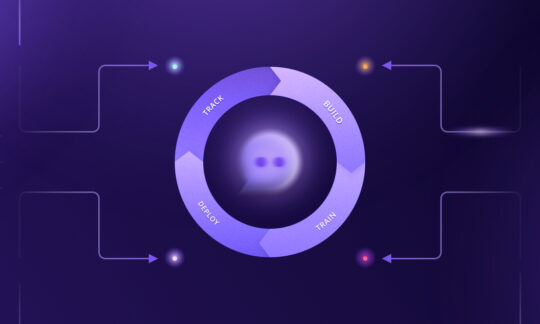How to Design an Effective Chatbot
Table of contents
- What is Chatbot Design?
- Establishing the Purpose of Your Chatbot
- Chatbot Persona vs Chatbot Personality
- How Different Channels Influence the Bot Design Process
- Testing, Improving, and Adapting Your Conversation Flow
- Good vs Bad Chatbot Design – An Overview
- Utilizing the Power of Generative AI in Chatbot Building Process
- Useful Resources for Bot Designers
- Choose the Right Chatbot Building Platform for You
- Article Summary
The beauty of chatbot design lies in the inherent freedom of the process. Aside from purely technological limitations, there are no roadblocks barring you from exploring specific paths, workflows, and traits of your chatbot. While all that may sound liberating, analysis paralysis can quickly overwhelm a beginner bot designer as they struggle to answer the question “Alright, but how do I actually design a great chatbot?”
We’ve already defined a chatbot and walked you through all the elements of bot building. In the third part of our Bot Building Series, we’re going to dive deeper into the topic of chatbot design to help you make the right choices when designing conversations, defining your bot persona, testing and improving your conversation flow and more.
What is Chatbot Design?
Essentially, it’s about making a chatbot that talks like a person with whom a user can hold a conversation without feeling like they’re going in circles, or repeatedly running into a wall. Such frustrating experiences are the result of insufficient planning, misaligned goals, or a lack of basic understanding of each individual step in chatbot design.
Likewise, understanding why chatbot design is important can reveal the bigger picture of what you and your company stand to gain. If you create your own chatbot with intent and properly align it with your brand identity and values, you can help decrease the workload from your staff, save money, and provide better assistance to your clients.
Establishing the Purpose of Your Chatbot
Chatbot is the face of your brand. Proper chatbot design needs to account for that and aim to create a cohesive and accurate representative of your company, acting in line with your core values. It’s crucial to make a chatbot look and feel like an integral extension of your brand, and not like a separate entity. Failing to do so risks damaging brand identity and giving misleading impressions to your clients.
Speaking of clients, one of the first steps of bot building should always involve considering your customers’ needs and goals. If you don’t know them, you can’t help them, it’s as simple as that. Conversely, your company’s own view of what goals you want the chatbot to achieve should be an equally strong driving force in the chatbot design process. This is a topic we’ve discussed at length in the last part of our chatbot building series, but to sum up, these goals will largely depend on your industry, and the scope of tasks you want to program your chatbot to help you with. For instance, if you’re aiming to implement a chatbot as an additional means of acquiring new customers, you need to design its conversation accordingly. Your chatbot will need to know how to pitch your product, inform buyers about what they get by purchasing the product or service you offer and of any potential advantages over going with your brand’s competition, and many more. Chatbots employed for more general customer service purposes will need training in answering frequently occurring questions and providing account information, order tracking, payment processing, etc.
This list could go on endlessly. A good understanding of both your audience and your business goals is a crucial step to consider before tackling our next topic, and the first true step of chatbot development – your chatbot’s persona and personality.
Chatbot Persona vs Chatbot Personality
To put it simply, the chatbot persona is the outward image you will broadcast to the world: your chatbot’s gender, language, age, role in customer service, the tasks it can assist with, its values and interests, and how its persona overall corresponds to your brand’s identity.
Chatbot personality, on the other hand, can be more narrowly defined as the character of the bot and how it expresses and behaves itself. The key aspect separating the two is that, unlike the persona, the chatbot’s personality changes depending on the situation. You can (and should) freely adapt the tone of voice and “flavour” of your chatbot to different scenarios.
The difference between persona and personality is best illustrated with an example: if you’re implementing a chatbot for a banking app, its tone of voice will be vastly different when interacting with first-time clients where the bot needs to be helpful and patient. In another situation, e.g. when a client reports fraud, the focus should be placed on reassurance and calming the user down. Both cases show a professional personality. When considering the appropriate chatbot persona here, it should probably land somewhere in the ballpark of a trustworthy, mature-sounding bot who is knowledgeable about finance, investing, and helping you keep your savings safe. What the chatbot persona should never be in a banking scenario, however, is an angsty teenager who responds in emojis. You get the picture.
How Different Channels Influence the Bot Design Process
As we mentioned, it’s imperative that your chatbot’s look and feel are consistent with your brand. Should you choose a webchat to be your primary deployment channel, since it allows you to customise pretty much everything, it’d be smart to make the chatting experience consistent with your brand’s colour scheme and give them a recognisable avatar. The opposite is true for WhatsApp, for example, where customisation is limited to text only, making it all the more important to ensure you design your conversation flows with extra care to keep them in line with your brand’s communication style.
Want to see a fantastic example of a chatbot persona and personality in perfect harmony with a company’s brand identity? Take a look at FlyPlay’s travel assistant extraordinaire – Playfin, who happily guides wishful holidaymakers through the booking process. Or Joshua, a friendly bot representing Slider that’s greeting website visitors with a bunch of emojis and a gif.
Testing, Improving, and Adapting Your Conversation Flow
This is another point we discussed at length in the previous article, but a quick refresher wouldn’t hurt.
Building your own chatbot does not end at the moment of product launch. In truth, your job isn’t really ever finished, as it’s essentially impossible to fully predict all of your customers’ needs based on raw data and a few brainstorming sessions. Be ready to continuously iterate on your chatbot once it goes live, identify flaws in its design, and improve/expand its functionality as necessary based on regularly gathered metrics (which calls back to the importance of establishing chatbot KPIs in the first place).
Not sure how to accurately track your bot’s performance post-launch? SentiOne Automate has a great feature for automated testing, tracking various metrics, and generating performance reports.
Good vs Bad Chatbot Design – An Overview
How do you spot a poorly-designed chatbot? It’s stiff, robotic and simply crumbles at the first hurdle, not resembling human-to-human conversation. It confuses the users as to what it can help them with and breaks whenever it’s been asked an unexpected question (with a typo, slang, or in an unusual manner).
A well-designed chatbot should explain its capabilities straight away, at the start of the conversation. Customers need to be made aware of what they can expect from the chatbot so as to not end up frustrated when seeking information or help. This is why it’s better to avoid going the low-effort route and opening the dialogue with a general “Feel free to ask me anything” with no extra context.
Also, as trivial as it sounds, throwing a little bit of small talk into your conversation flow might help you build a relationship between your customers and your brand. A user innocently asking the chatbot about its day and getting a cold “I’m sorry, I don’t understand” back won’t get you far.
To summarise, here’s a quick list of good chatbot design practices:
- Consistent with the goals
- Persona fits the industry; personality adapts to different scenarios accordingly
- Clearly explains its capabilities from the start
- Sets expectations and utilises clear, targeted copy to not confuse and mislead users
Utilising the Power of Generative AI in Chatbot Building Process
By now, you probably know what generative AI is. With ChatGPT being hailed as the harbinger of a new technological age, taking a look at its potential applicability in chatbot design is surely warranted.
Generative AI tools like ChatGPT can to an extent be used to facilitate building a chatbot. Say, for example, you want your chatbots to answer some FAQs. ChatGPT can help generate some questions to make sure you’re not overlooking anything. Additionally, nothing’s stopping you from asking it to generate 15 ways a user may ask about their current account balance. Then you can simply feed these inputs directly into your chatbot’s NLU model. Overall, it’s a pretty useful addition to a chatbot designer’s toolbox.
Useful Resources for Bot Designers
At this point, you’re likely feeling rather overwhelmed. But don’t panic – Rome wasn’t built in a day, and there is a plethora of phenomenal resources available online to keep brushing up your knowledge in chatbot design.
Sites like VUX World or voicebot.ai are basically free encyclopaedias full of chatbot wisdom. You’ll find plenty of guides and articles to read, as well as podcasts to listen to. Google has also dipped their toes in this pool and consistently uploads great articles on conversation design on their dedicated Google Design hub. And if you’re itching to learn more in person, Botrepreneurs.live has got you covered! Use their website to fill up your calendar, but also keep your eyes peeled for the next editions of events such as the Conversation Design Festival or the European Chatbot & AI Summit.
SentiOne is also committed to teaching you the ins and outs of bot building. You can check out one of our conversational AI webinars on YouTube or head over to the next part of the Bot Building series about chatbot training.
Choose the Right Chatbot Building Platform for You
You can’t build a chatbot without a dedicated chatbot building platform. Beginner designers will likely want to stay away from highly technical platforms, as their rather unintuitive interfaces may pose a challenge to those less experienced with code. For that reason, platforms like Rasa, though excellent in their own right, might not be the best starting point.
If you want a more accessible choice, one that’s utilising both a very UX-friendly, low-code/no-code interface and proprietary high-end AI solutions, SentiOne Automate is the platform for you. Feel free to reach out to our team of experts if you have any questions about bot design.
Please note that when discussing chatbots, we also mean voice bots. The primary distinction between them is the mode of communication, but they share the same underlying technology, with the addition of voice-specific technologies. Consequently, both solutions have similar use cases. Therefore, the principles discussed in the Bot Building Series can be applied to both chatbots and voice bots without any significant differences.
Article Summary
The article discusses the process of designing a chatbot. It emphasises the importance of planning, understanding customer needs and business goals, and creating a chatbot that aligns with the brand’s identity. In the article, we explore the concepts of chatbot persona and personality, highlighting the need for consistency and adaptability in different scenarios. We also discuss how different communication channels influence the design process. We emphasise the importance of testing, improving, and adapting the conversation flow of a chatbot even after its launch. The article also mentions the potential use of generative AI tools like ChatGPT in chatbot design.



